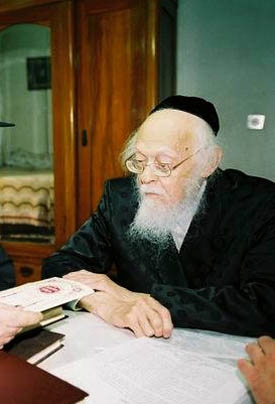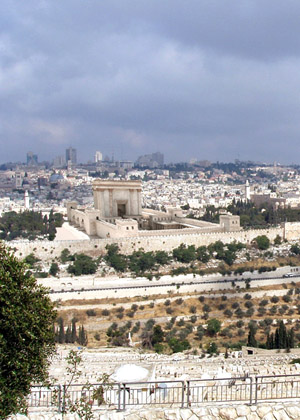 |
NEWS: December 20, 2004
Bird’s Eye View of the News
Atila Sinke Guimarães
JEWISH SANHEDRIN RE-ESTABLISHED - On October 13, the Sanhedrin, the highest tribunal of the Jewish state and religion, was re-inaugurated by a group of rabbis in Tiberias after 1,600 years of absence. According to Jewish sources, last notice of the Sanhedrin dates around 425 A.D., also in the city of Tiberias. After that, it ceased to exist (Israel National News online edition, October 13, 2004).
A bit of History
The idea of a Jewish tribunal originated with Jethro, who advised Moses, his son-in-law, to choose a group of elderly men to help him judge the people (Ex 18:17-26). It was officially founded when God ordered Moses to choose 70 men from Israel (Num 11:16) and bring them before the Tabernacle (a tent pre-figuring the Temple), where they would receive enlightenment to judge the people who violated Jewish law. This tribunal became known as Sanhedrin, derivate from the Greek word sunedrion , literally, "sitting together."
Historically speaking, this tribunal had little influence until the Jewish exile under the Persians, when it started to effectively judge the difficult questions of the Jewish people. This court of 71 counted 70 of the more important members of the Jewish families, both priests and lay people, plus the high-priest (F. Vigouroux, Dictionnaire de la Bible, entry Sanhedrin, vol. V, cols. 1459-1462).
The tribunal had a varied importance in the Old Covenant. At the time of Our Lord, the Sanhedrin of Jerusalem was effectively the nation’s Supreme Court of Justice. It rejected Our Lord and His doctrine, and condemned Him to death (Math 27:1,2). With this it assumed a great part of the responsibility for the crime of Deicide.
After this crime and the corresponding chastisements – the destruction of the Temple in 70 AD by Titus and the destruction of the Jewish nation in 130 AD by Adrian – the Sanhedrin disappeared. It was said that it was reconstituted at Jabné, but that tribunal issued only theoretical decisions, and could not be called the effective continuation of the old Sanhedrin (F. Vigouroux, ibid). I could not find historical data tracing its move from Jabné to Tiberias in the 5th century, where Jews say it definitively ceased to exist.
The new Sanhedrin
The ceremony that took place in Israel on October 13, 2004 brought together 71 rabbis. One of the leaders of the initiative to revive the Sanhedrin is rabbi Yeshai Baavad. He said that the 71 rabbis "from across the spectrum received the special ordination, in accordance with Maimonides' rulings, over the past several months." Rabbi Baavad explained the aim of the reconstituted body:

Rabbi Israel Ariel, founder of the Temple Institute, inspects a menorah for the new Temple - Temple Institute website |
"The goal is to have one rabbinic body in Jerusalem that will convene monthly and issue rulings on central issues. This is the need of the generation and of the hour" (Israel National News, ibid).
Rabbi Israel Ariel, who heads the Temple institute in Jerusalem, is one of the participating rabbis. He explained some of the reasons they decided to make this attempt to reconvene the Sanhedrin:
"Whether this will be the actual Sanhedrin that we await, is a question of time - just like the establishment of the State. We rejoiced in it, but we are still awaiting something much more ideal. It's a process. Today's ceremony is really the continuation of the renewal of the ordination process in Israel …..
"Our talmudic sages describe the ten stages of exile of the Sanhedrin from Jerusalem to other locations, until it ended in Tiberias - and this is the place where it was foretold that it would be renewed, and from here it will be relocated to Jerusalem" (Ibid.).

Josef Elyashiv, supposed successor to Moses and present day Jewish high priest |
Rabbi Meir Halevi, one of the 71 members, told Israel National Radio’s weekend edition the juridical background of the plan:
“There is a special commandment, not connected to time, but tied to our presence in Israel, to establish a Sanhedrin …. The Rambam [12th-century rabbi Maimonides] describes the process exactly in the Mishna Torah. When he wrote it, there was no Sanhedrin, and he therefore outlines the steps necessary to establish one. When there is a majority of rabbis in Israel who authorize one person to be an authority, he can then reestablish the Sanhedrin” (Israel National News, online edition, December 9, 2004).
There are two men behind the re-establishment of the Sanhedrin: Ovadiah Josef and Josef Elyashiv. The former is a chief rabbi of the Sefardi Jews and the latter a chief rabbi of the Ashkenazi Jews. Elyashiv is considered the spiritual heir of Moses, able to ordain the 70 others.
The rabbis behind the Sanhedrin’s reconstitution claim that, like the State of Israel, the new Sanhedrin is a work-in-progress. They see it as an institution that, once established, will reach the stature and authority that it once had.
Halevi explained how the new Sanhedrin wanted to strengthen as an institution:
“The first members [of the new Sanhedrin] requested that their names not be published, so as to allow it to grow without public criticism of individuals. We want to give it time to develop and strengthen the institution, giving a chance for more rabbis to join.”
He added that each of the current members of the Sanhedrin had agreed to be a conditional member until more knowledgeable rabbis would enter the ranks and take his place (Israel National News, December 9, 2004).
A Catholic judgment on these facts
Anyone who studies a little about Judaism realizes that it is a religion broken into innumerable factions that fight one another. It lacks unity. It is only united against the Catholic cause. That is, when it is a question of attacking the Catholic Church and Christendom, then all its fragmented sects unite and join forces.
The founding of the State of Israel in 1948 (a reality still not entirely accepted either de facto or de jure), the adoption of Hebrew as its official language (although not yet spoken in the whole country), and the struggle to make an officially religious State are clear goals of the Zionist movement. They were intended to bring unity to a nomad people, whose history knew no more than three short periods of unity and stability: under Abraham and Jacob; under David and Solomon, and under the Macabees. The rest of its Old Testament history is that of successive punishments for its unfaithfulness to the True God. In the New Covenant, it was a people without any political or religious unity, its just punishment for the killing of the True Messiah, Our Lord Jesus Christ.

A hypothetical view of the new Temple and its placement in present day Jerusalem |
With Jesus Christ, the authentic Judaism was transformed into the Catholic Church. The false religion that continued to exist using the name of Judaism is born from the rejection of Our Lord and rebellion against the Catholic Church. It is, therefore, a rebellion against God. The rebellion persists in the goal of the present day Jewish religion and the Zionist movement, which aims for Israel’s hegemony over all the nations of the world.
The rebellion of the Jews against Jesus Christ and the true Religion is particularly offensive to God, Who had chosen them to be the natural followers of His Son. Their attempt to re-establish Jewish institutions that were symbols given by God as proof of His predilection also is, in my opinion, an affront to God. I am speaking about the return of the Jews to the Holy Land, their usurpation of Jerusalem as their capital, their attempt to rebuild the Temple, and now this re-inauguration of the Sanhedrin.
Therefore, reestablishing these symbols independent of Jesus Christ’s mission and the arrogant reaffirmation of their errors display an audacity that can only raise the wrath of God.
An attempt to rebuilt the Temple was made by the Jews with the approval of Emperor Julian the Apostate in the 4th century. The project came to a halt after natural catastrophes in Jerusalem made construction impossible. God’s message was understood, and no new attempt was made until today. It is common knowledge that a plan is underway at present time to rebuild the Temple. The only obstacles in way of executing the project are the two mosques that stand on the original Temple site.
The founding of Israel, the usurpation of Jerusalem and the reestablishment of the Sanhedrin certainly, are symbolic actions that offend the heart of God keenly.
Let us see how long He will tolerate such affronts.


Related Topics of Interest
 Paul VI Wears the Jewish Symbol of the High Priest Paul VI Wears the Jewish Symbol of the High Priest
 Carmelites in Israel Stop Praying for the Conversion of the Jews Carmelites in Israel Stop Praying for the Conversion of the Jews
 Pagan Sects Worship False Gods in Catholic Churches in Assisi Pagan Sects Worship False Gods in Catholic Churches in Assisi

| Related Works of Interest
|
News | Home | Books | CDs | Search | Contact Us | Donate

© 2002- Tradition in Action, Inc. All Rights Reserved
|
 |
|